Encryption #
Process Details #
DBPlusEngine can encrypt the plaintext by parsing and rewriting SQL according to the encryption rule, and store the plaintext (optional) and ciphertext data to the database at the same time. Queries data only extracts the ciphertext data from database and decrypts it, and finally returns the plaintext to user. DBPlusEngine transparently process of data encryption, so that users do not need to know to the implementation details of it, use encrypted data just like as regular data. In addition, DBPlusEngine can provide a relatively complete set of solutions whether the online business system has been encrypted or the new online business system uses the encryption function.
Overall Architecture #
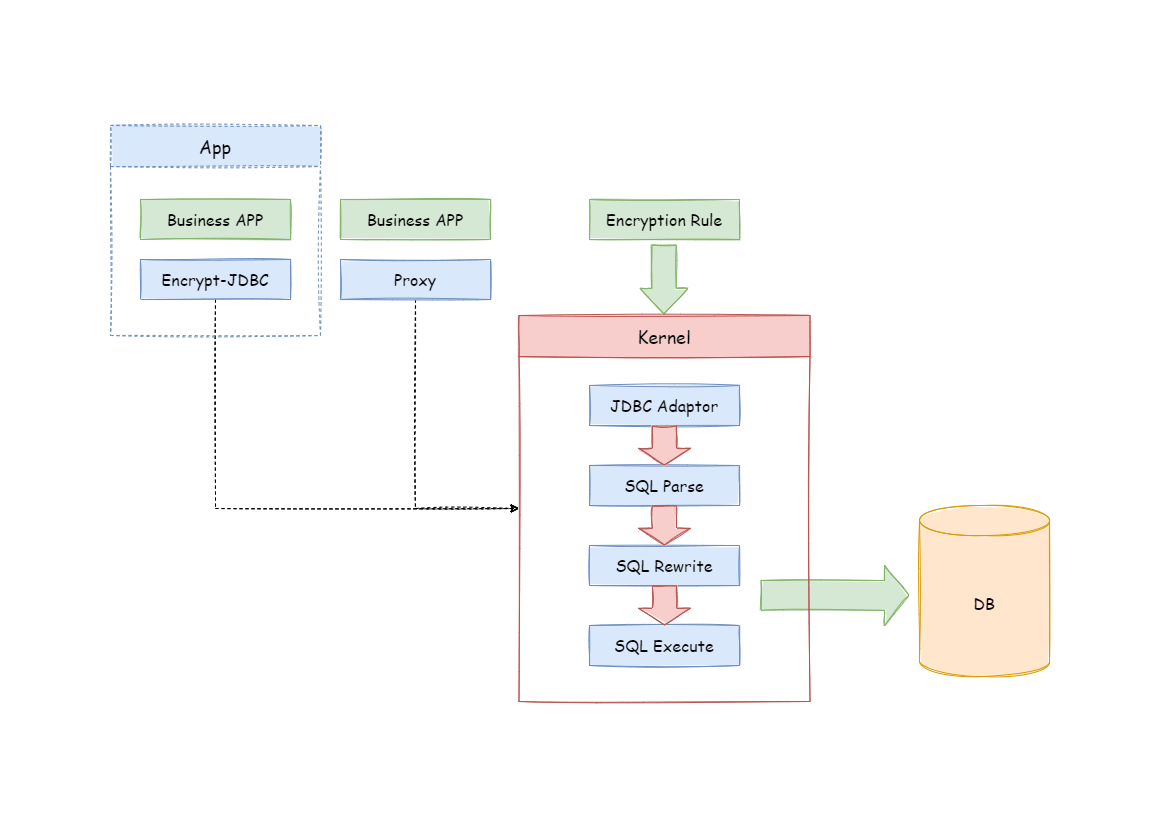
Encrypt module intercepts SQL initiated by user, analyzes and understands SQL behavior through the SQL syntax parser. According to the encryption rules passed by the user, find out the fields that need to be encrypted/decrypted and the encryptor/decryptor used to encrypt/decrypt the target fields, and then interact with the underlying database. DBPlusEngine will encrypt the plaintext requested by the user and store it in the underlying database; and when the user queries, the ciphertext will be taken out of the database for decryption and returned to the end user. DBPlusEngine shields the encryption of data, so that users do not need to perceive the process of parsing SQL, data encryption, and data decryption, just like using ordinary data.
Encryption Rule #
Before explaining the whole process in detail, we need to understand the encryption rules and configuration, which is the basis of understanding the whole process. The encryption configuration is mainly divided into four parts: data source configuration, encrypt algorithm configuration, encryption table rule configuration, and query attribute configuration. The details are shown in the following figure:
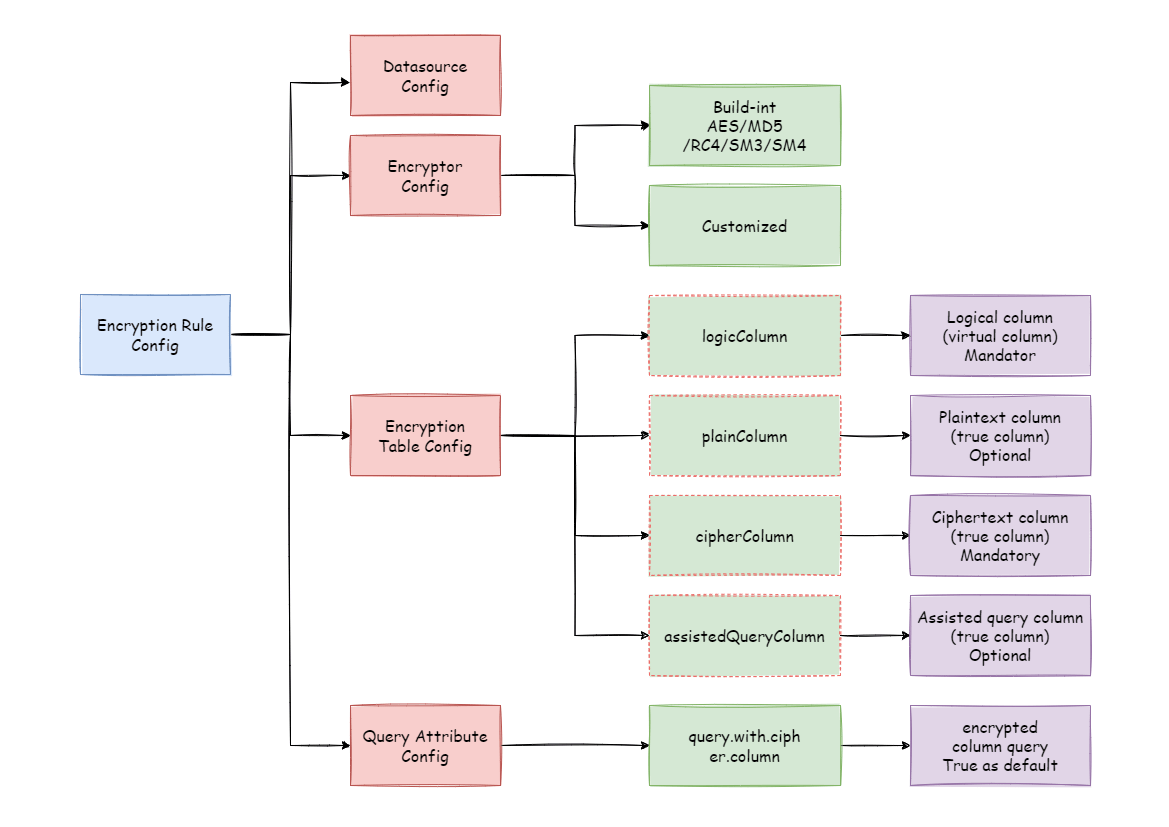
Datasource Configuration:The configuration of DataSource.
Encrypt Algorithm Configuration:What kind of encryption strategy to use for encryption and decryption. Currently DBPlusEngine has five built-in encryption/decryption strategies: AES, MD5, RC4, SM3, and SM4. Users can also implement a set of encryption/decryption algorithms by implementing the interface provided by DBPlusEngine.
Encryption Table Configuration:Show the DBPlusEngine data table which column is used to store cipher column data (cipherColumn), which column is used to store plain text data (plainColumn), and which column users want to use for SQL writing (logicColumn)
How to understand
Which column do users want to use to write SQL (logicColumn)?We can understand according to the meaning of DBPlusEngine. The ultimate goal of DBPlusEngine is to shield the encryption of the underlying data, that is, we do not want users to know how the data is encrypted/decrypted, how to store plaintext data in plainColumn, and ciphertext data in cipherColumn. In other words, we do not even want users to know the existence and use of plainColumn and cipherColumn. Therefore, we need to provide users with a column in conceptual. This column can be separated from the real column of the underlying database. It can be a real column in the database table or not, so that the user can freely change the plainColumn and The column name of cipherColumn. Or delete plainColumn and choose to never store plain text and only store cipher text. As long as the user’s SQL is written according to this logical column, and the correct mapping relationship between logicColumn and plainColumn, cipherColumn is given in the encryption rule.
Why do you do this? The answer is at the end of the article, that is, to enable the online services to seamlessly, transparently, and safely carry out data encryption migration.
Query Attribute configuration:When the plaintext data and ciphertext data are stored in the underlying database table at the same time, this attribute switch is used to decide whether to directly query the plaintext data in the database table to return, or to query the ciphertext data and decrypt it through DBPlusEngine to return.
Encryption Process #
For example, if there is a table in the database called t_user, there are actually two fields pwd_plain in this table, used to store plain text data, pwd_cipher, used to store cipher text data, and define logicColumn as pwd.
Then, when writing SQL, users should write to logicColumn, that is, INSERT INTO t_user SET pwd = '123'.
DBPlusEngine receives the SQL, and through the encryption configuration provided by the user, finds that pwd is a logicColumn, so it decrypt the logical column and its corresponding plaintext data.
As can be seen that DBPlusEngine has carried out the column-sensitive and data-sensitive mapping conversion of the logical column facing the user and the plaintext and ciphertext columns facing the underlying database.
As shown below:
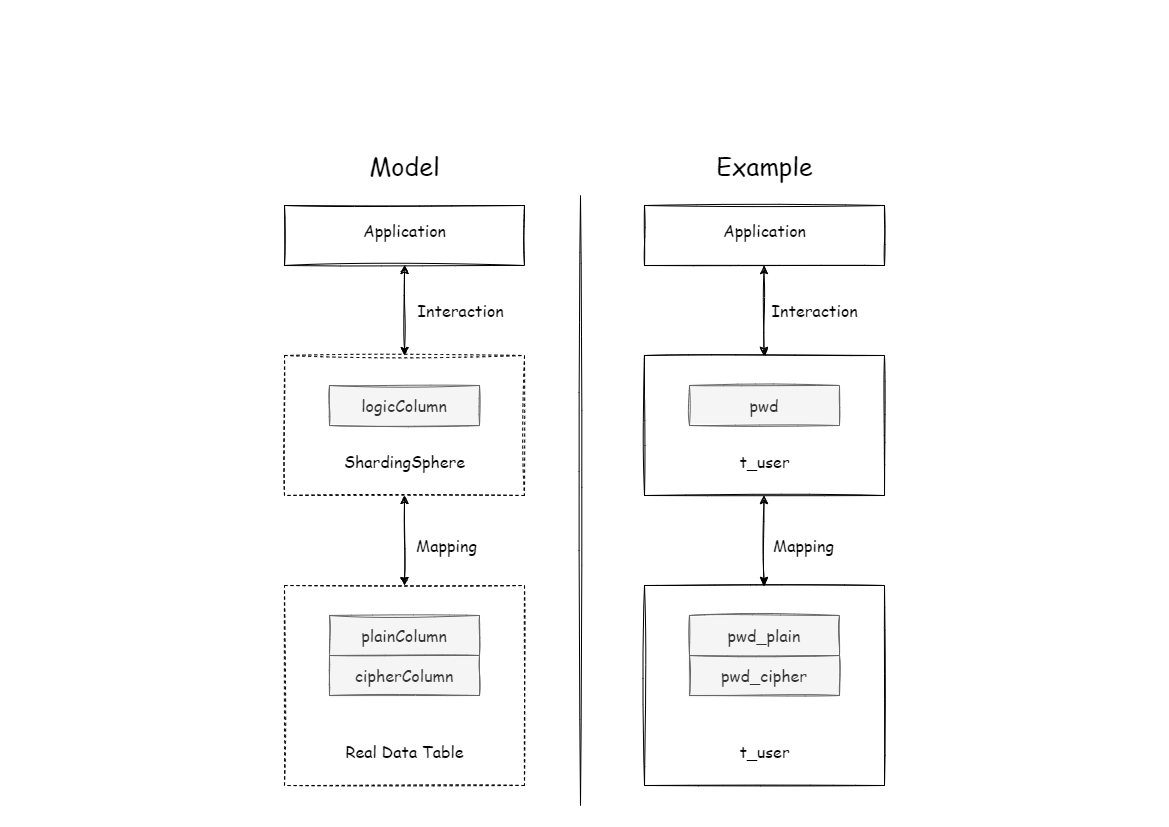
This is also the core meaning of DBPlusEngine, which is to separate user SQL from the underlying data table structure according to the encryption rules provided by the user, so that the SQL writer by user no longer depends on the actual database table structure. The connection, mapping, and conversion between the user and the underlying database are handled by DBPlusEngine. Why should we do this? It is still the same : in order to enable the online business to seamlessly, transparently and safely perform data encryption migration.
In order to make the reader more clearly understand the core processing flow of DBPlusEngine, the following picture shows the processing flow and conversion logic when using DBPlusEngine to add, delete, modify and check, as shown in the following figure.
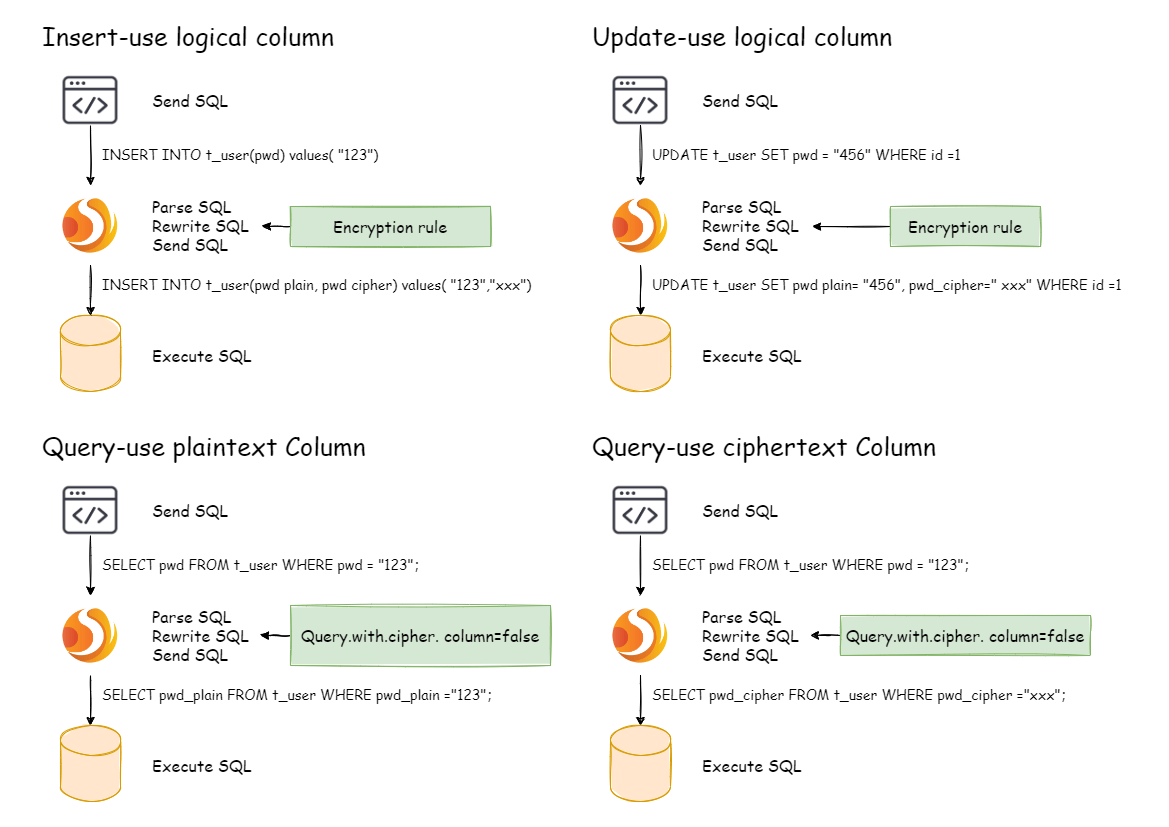
Detailed Solution #
After understanding the DBPlusEngine encryption process, you can combine the encryption configuration and encryption process with the actual scenario. All design and development are to solve the problems encountered in business scenarios. So for the business scenario requirements mentioned earlier, how should DBPlusEngine be used to achieve business requirements?
New Business #
Business scenario analysis: The newly launched business is relatively simple because everything starts from scratch and there is no historical data cleaning problem.
Solution description: After selecting the appropriate encrypt algorithm, such as AES, you only need to configure the logical column (write SQL for users) and the ciphertext column (the data table stores the ciphertext data). It can also be different **. The recommended configuration is as follows (shown in Yaml format):
-!ENCRYPT
encryptors:
aes_encryptor:
type: AES
props:
aes-key-value: 123456abc
tables:
t_user:
columns:
pwd:
cipherColumn: pwd
encryptorName: aes_encryptor
With this configuration, DBPlusEngine only needs to convert logicColumn and cipherColumn. The underlying data table does not store plain text, only cipher text. This is also a requirement of the security audit part. If users want to store plain text and cipher text together in the database, they just need to add plainColumn configuration. The overall processing flow is shown below:
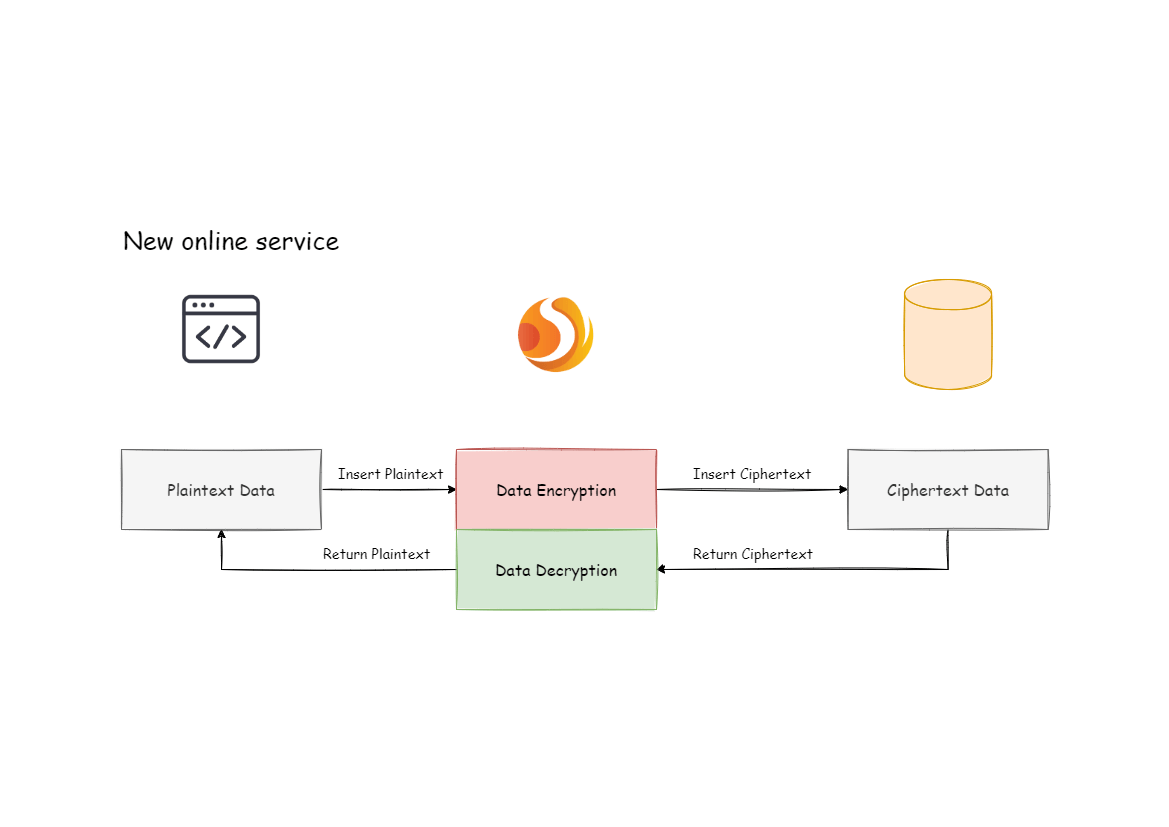
Online Business Transformation #
Business scenario analysis: As the business is already running online, there must be a large amount of plain text historical data stored in the database. The current challenges are how to enable historical data to be encrypted and cleaned, how to enable incremental data to be encrypted, and how to allow businesses to seamlessly and transparently migrate between the old and new data systems.
Solution description: Before providing a solution, let ’s brainstorm: First, if the old business needs to be desensitized, it must have stored very important and sensitive information. This information has a high gold content and the business is relatively important. If it is broken, the whole team KPI is over. Therefore, it is impossible to suspend business immediately, prohibit writing of new data, encrypt and clean all historical data with an encrypt algorithm, and then deploy the previously reconstructed code online, so that it can encrypt and decrypt online and incremental data. Such a simple and rough way, based on historical experience, will definitely not work.
Then another relatively safe approach is to rebuild a pre-release environment exactly like the production environment, and then encrypt the Inventory plaintext data of the production environment through the relevant migration and washing tools and store it in the pre-release environment. The Increment data is encrypted by tools such as MySQL replica query and the business party ’s own development, encrypted and stored in the database of the pre-release environment, and then the refactored code can be deployed to the pre-release environment. In this way, the production environment is a set of environment for modified/queries with plain text as the core; the pre-release environment is a set of encrypt/decrypt queries modified with ciphertext as the core. After comparing for a period of time, the production flow can be cut into the pre-release environment at night. This solution is relatively safe and reliable, but it takes more time, manpower, capital, and costs. It mainly includes: pre-release environment construction, production code rectification, and related auxiliary tool development. Unless there is no way to go, business developers generally go from getting started to giving up.
Business developers must hope: reduce the burden of capital costs, do not modify the business code, and be able to safely and smoothly migrate the system. So, the encryption function module of DBPlusEngine was born. It can be divided into three steps:
- Before system migration
Assuming that the system needs to encrypt the pwd field of t_user, the business side uses DBPlusEngine to replace the standardized JDBC interface, which basically requires no additional modification (we also provide Spring Boot Starter, Spring Namespace, YAML and other access methods to achieve different services demand). In addition, demonstrate a set of encryption configuration rules, as follows:
-!ENCRYPT
encryptors:
aes_encryptor:
type: AES
props:
aes-key-value: 123456abc
tables:
t_user:
columns:
pwd:
plainColumn: pwd
cipherColumn: pwd_cipher
encryptorName: aes_encryptor
queryWithCipherColumn: false
According to the above encryption rules, we need to add a column called pwd_cipher in the t_user table, that is, cipherColumn, which is used to store ciphertext data.
At the same time, we set plainColumn to pwd, which is used to store plaintext data, and logicColumn is also set to pwd.
Because the previous SQL was written using pwd, that is, the SQL was written for logical columns, so the business code did not need to be changed.
Through DBPlusEngine, for the incremental data, the plain text will be written to the pwd column, and the plain text will be encrypted and stored in the pwd_cipher column.
At this time, because queryWithCipherColumn is set to false, for business applications, the plain text column of pwd is still used for query storage,
but the cipher text data of the new data is additionally stored on the underlying database table pwd_cipher. The processing flow is shown below:
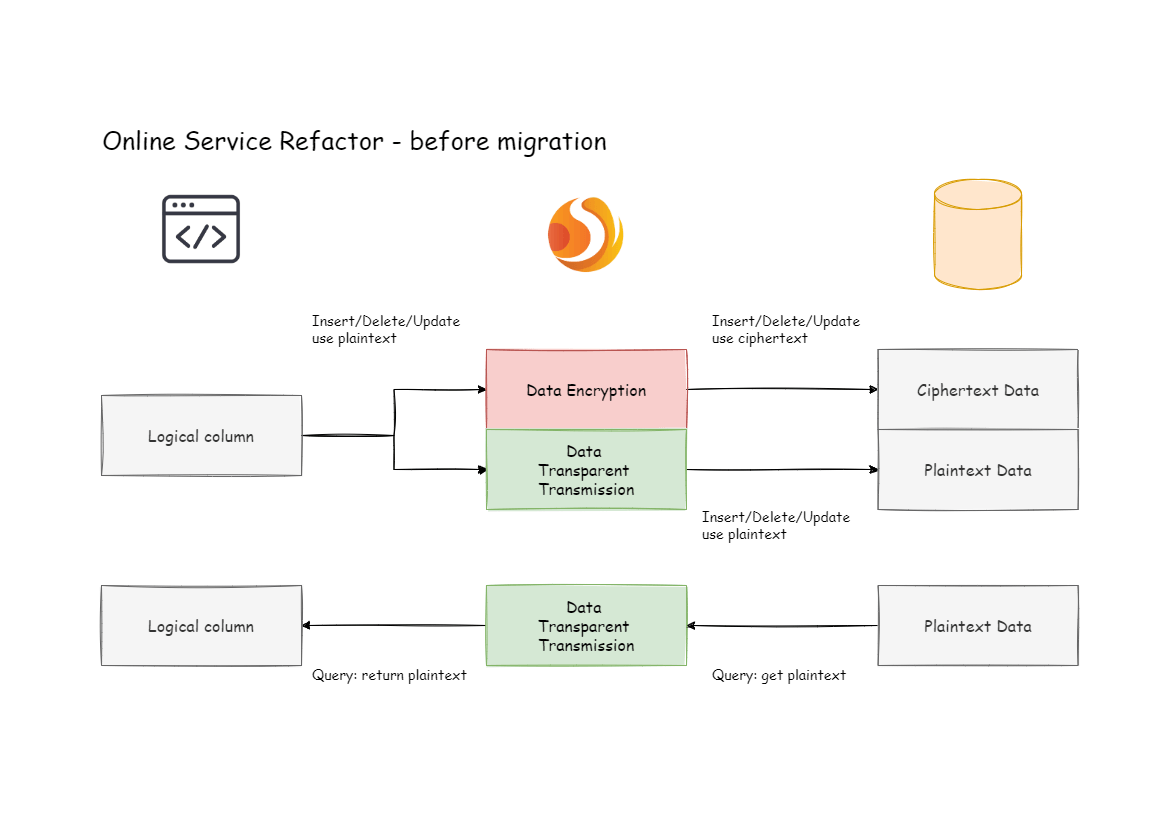
When the newly added data is inserted, it is encrypted as ciphertext data through DBPlusEngine and stored in the cipherColumn. Now it is necessary to process historical plaintext inventory data. As DBPlusEngine currently does not provide the corresponding migration and washing tools, the business party needs to encrypt and store the plain text data in pwd to pwd_cipher.
- During system migration
The incremental data has been stored by DBPlusEngine in the ciphertext column and the plaintext is stored in the plaintext column; after the historical data is encrypted and cleaned by the business party itself,
the ciphertext is also stored in the ciphertext column. That is to say, the plaintext and the ciphertext are stored in the current database.
Since the queryWithCipherColumn = false in the configuration item, the ciphertext has never been used.
Now we need to set the queryWithCipherColumn in the encryption configuration to true in order for the system to cut the ciphertext data for query.
After restarting the system, we found that the system business is normal, but DBPlusEngine has started to extract the ciphertext data from the database,
decrypt it and return it to the user; and for the user’s insert, delete and update requirements,
the original data will still be stored The plaintext column, the encrypted ciphertext data is stored in the ciphertext column.
Although the business system extracts the data in the ciphertext column and returns it after decryption;
however, it will still save a copy of the original data to the plaintext column during storage.
Why? The answer is: in order to be able to roll back the system.
Because as long as the ciphertext and plaintext always exist at the same time, we can freely switch the business query to cipherColumn or plainColumn through the configuration of the switch item.
In other words, if the system is switched to the ciphertext column for query, the system reports an error and needs to be rolled back.
Then just set queryWithCipherColumn = false, Apache ShardingSphere will restore, that is, start using plainColumn to query again.
The processing flow is shown in the following figure:
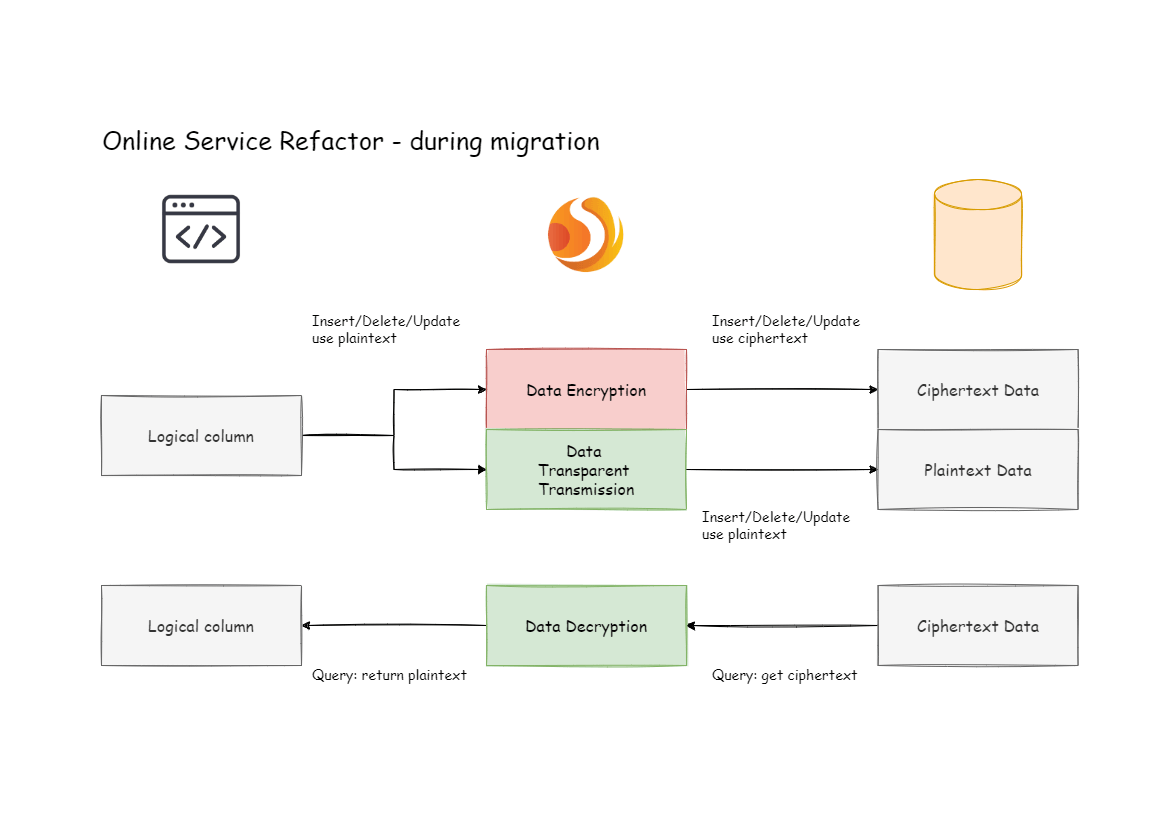
- After system migration
Due to the requirements of the security audit department, it is generally impossible for the business system to keep the plaintext and ciphertext columns of the database permanently synchronized. We need to delete the plaintext data after the system is stable. That is, we need to delete plainColumn (ie pwd) after system migration. The problem is that now the business code is written for pwd SQL, delete the pwd in the underlying data table stored in plain text, and use pwd_cipher to decrypt to get the original data, does that mean that the business side needs to rectify all SQL, thus Do not use the pwd column that is about to be deleted? Remember the core meaning of our encrypt module?
This is also the core meaning of encrypt module. According to the encryption rules provided by the user, the user SQL is separated from the underlying database table structure, so that the user’s SQL writing no longer depends on the actual database table structure. The connection, mapping, and conversion between the user and the underlying database are handled by DBPlusEngine.
Yes, because of the existence of logicColumn, users write SQL for this virtual column. DBPlusEngine can map this logical column and the ciphertext column in the underlying data table. So the encryption configuration after migration is:
-!ENCRYPT
encryptors:
aes_encryptor:
type: AES
props:
aes-key-value: 123456abc
tables:
t_user:
columns:
pwd: # pwd and pwd_cipher transformation mapping
cipherColumn: pwd_cipher
encryptorName: aes_encryptor
The processing flow is as follows:

So far, the online service encryption and rectification solutions have all been demonstrated. We provide Java, YAML, Spring Boot Starter, Spring Namespace multiple ways for users to choose to use, and strive to fulfill business requirements. The solution has been continuously launched on JD Digits, providing internal basic service support.
The advantages of Middleware encryption service #
- Transparent data encryption process, users do not need to pay attention to the implementation details of encryption.
- Provide a variety of built-in, third-party (AKS) encryption strategies, users only need to modify the configuration to use.
- Provides a encryption strategy API interface, users can implement the interface to use a custom encryption strategy for data encryption.
- Support switching different encryption strategies.
- For online services, it is possible to store plaintext data and ciphertext data synchronously, and decide whether to use plaintext or ciphertext columns for query through configuration. Without changing the business query SQL, the on-line system can safely and transparently migrate data before and after encryption.
Solution #
DBPlusEngine has provided two data encryption solutions, corresponding to two DBPlusEngine encryption and decryption interfaces, i.e., EncryptAlgorithm and QueryAssistedEncryptAlgorithm.
On the one hand, DBPlusEngine has provided internal encryption and decryption implementations for users, which can be used by them only after configuration. On the other hand, to satisfy users’ requirements for different scenarios, we have also opened relevant encryption and decryption interfaces, according to which, users can provide specific implementation types. Then, after simple configurations, DBPlusEngine can use encryption and decryption solutions defined by users themselves to desensitize data.
EncryptAlgorithm #
The solution has provided two methods encrypt() and decrypt() to encrypt/decrypt data for encryption.
When users INSERT, DELETE and UPDATE, DBPlusEngine will parse, rewrite and route SQL according to the configuration. It will also use encrypt() to encrypt data and store them in the database. When using SELECT,
they will decrypt sensitive data from the database with decrypt() reversely and return them to users at last.
Currently, DBPlusEngine has provided three types of implementations for this kind of encrypt solution, MD5 (irreversible), AES (reversible) and RC4 (reversible), which can be used after configuration.
QueryAssistedEncryptAlgorithm #
Compared with the first encrypt scheme, this one is more secure and complex. Its concept is: even the same data, two same user passwords for example, should not be stored as the same desensitized form in the database. It can help to protect user information and avoid credential stuffing.
This scheme provides three functions to implement, encrypt(), decrypt() and queryAssistedEncrypt().
In encrypt() phase, users can set some variable, timestamp for example, and encrypt a combination of original data + variable.
This method can make sure the encrypted data of the same original data are different, due to the existence of variables.
In decrypt() phase, users can use variable data to decrypt according to the encryption algorithms set formerly.
Though this method can indeed increase data security, another problem can appear with it: as the same data is stored in the database in different content,
users may not be able to find out all the same original data with equivalent query (SELECT FROM table WHERE encryptedColumnn = ?) according to this encryption column.
Because of it, we have brought out assistant query column, which is generated by queryAssistedEncrypt().
Different from decrypt(), this method uses another way to encrypt the original data;
but for the same original data, it can generate consistent encryption data. Users can store data processed by queryAssistedEncrypt() to assist the query of original data.
So there may be one more assistant query column in the table.
queryAssistedEncrypt() and encrypt() can generate and store different encryption data; decrypt() is reversible and queryAssistedEncrypt() is irreversible.
So when querying the original data, we will parse, rewrite and route SQL automatically.
We will also use assistant query column to do WHERE queries and use decrypt() to decrypt encrypt() data and return them to users.
All these can not be felt by users.
For now, DBPlusEngine has abstracted the concept to be an interface for users to develop rather than providing accurate implementation for this kind of encrypt solution. DBPlusEngine will use the accurate implementation of this solution provided by users to desensitize data.